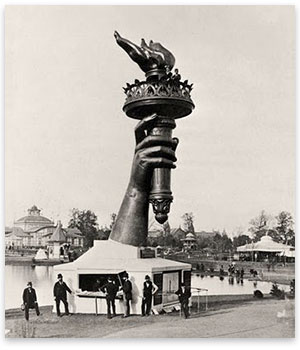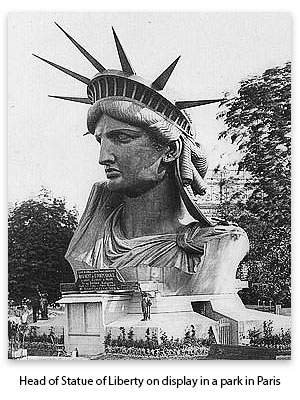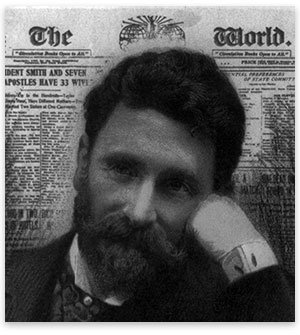 While visiting France recently, I posted to my blog about seeing Lady Liberty in Paris. I’m afraid I offhandedly gave a bit of false history in that post: on the subject of the Statue of Liberty I wrote, “The one in New York Harbor was a gift from the French government, so I can imagine Parisians consider Lady Liberty to be as much a French symbol as an American one.”
While visiting France recently, I posted to my blog about seeing Lady Liberty in Paris. I’m afraid I offhandedly gave a bit of false history in that post: on the subject of the Statue of Liberty I wrote, “The one in New York Harbor was a gift from the French government, so I can imagine Parisians consider Lady Liberty to be as much a French symbol as an American one.”
But the statue was not, in fact, a gift from the French government. I believe my mistake is based on a 20th-century reading of a 19th-century idiom.
The National Park Service, which maintains the monument, makes the claim I learned in grammar school: “The Statue of Liberty Enlightening the World was a gift of friendship from the people of France to the people of the United States.…”
To quote Max Borders from the Freeman, “There is probably no greater threat to real community than the conflation of community with State power.”
And yet that conflation surrounds us. I certainly grew up with it as a common refrain in my schooling. Most of the time when the teacher said “the people,” she meant the state.
Really, how can “the people of France” give anything to anyone? I just assumed it was the standard rhetorical trick, using the people as a euphemism for the government.
The real history turns out to be much more interesting. According to Lady with a Past by Elizabeth Mitchell, the statue’s designer, Frédéric Auguste Bartholdi, wanted wealth and world renown for building a celebrated colossus, and he was willing to shop the idea around. He was not a fan of the American people and wasn’t even particularly devoted to the idea of liberty: “The Americans believe that it is Liberty that illumines the world, but, in reality, it is my genius.”
His first pitch for a giant, torch-bearing statue was to the Ottoman viceroy of Egypt, which was, at the time, the single greatest commercial conduit for the international slave trade. (An interesting book on this period of Egyptian history is Dominic Green’s Three Empires on the Nile: The Victorian Jihad, 1869–1899 about the West’s crusade to abolish slavery in the East. Still hasn’t happened.)
The statue that now stands in New York Harbor is officially called “Liberty Enlightening the World” (La Liberté éclairant le monde). The statue in Egypt was to be called “Egypt Enlightening the World” or “Progress Enlightening the World” or, most awkwardly, “Egypt (or Progress) Carrying the Light to Asia.”
Failing to close the deal in Egypt, Bartholdi repackaged it for America.
When this bit of backstory reached the American public, while Liberty was still in the planning stages, “Bartholdi furiously denied the charge. And yet the similarity between ‘Egypt (or Progress) Enlightening the World’ and ‘Liberty Enlightening the World’ was so marked, even Bartholdi’s own listing of his holdings itemized the Egypt models as models for Liberty” (Elizabeth Mitchell, Lady with a Past).
 According to Mitchell, the Egyptian statue was the antithesis of liberty: an Egyptian slave!
According to Mitchell, the Egyptian statue was the antithesis of liberty: an Egyptian slave!
But I think that may be the author’s preference for a dramatic contrast trumping the facts. Both Mitchell and Wikipedia describe the proposed statue as an Egyptian female fellah. But were the fellahin slaves? Perhaps that’s a post for another time. Regardless, Egypt was a vassal state of an authoritarian empire and the gateway for the colossal African slave trade into Asia.
Bartholdi wanted to place his piece at the northern entrance to the Suez Canal in Port Said because the canal represented French greatness in general (Ferdinand de Lesseps had finally accomplished what Napoleon had envisioned but never completed — and what pharaohs and emperors had attempted since antiquity) and engineering greatness more specifically. His statue was to be a synthesis of French art and French engineering, as well as a political symbol of the progress that France offered the East.
But the canal itself, while a great engineering accomplishment, and a giant step forward for world trade and greater wealth and comfort for everyone, including the toiling masses, was built on the back of slave labor:
The excavation took some 10 years using forced labour (corvée) of Egyptian workers during a certain period. Some sources estimate that over 30,000 people were working on the canal at any given period, that altogether more than 1.5 million people from various countries were employed, and that thousands of laborers died on the project.
The British government had opposed the project of the canal from the outset to its completion. As one of the diplomatic moves against the canal, it disapproved the use of “slave labor” of forced workers on the canal. The British Empire was the major global naval force and officially condemned the forced work and sent armed Bedouins to start a revolt among workers. Involuntary labour on the project ceased, and the viceroy condemned the corvée, halting the project.
Angered by the British opportunism, de Lesseps sent a letter to the British government remarking on the British lack of remorse a few years earlier when forced workers died in similar conditions building the British railway in Egypt. (Wikipedia)
Even if the female fellah to be represented in “Egypt Enlightening the World” was not necessarily a slave in any permanent sense, her contemporary real-life counterpart was likely to have been drafted into the army of involuntary labor that built the canal over whose northern port she was to stand, “enlightening the world.”
Before Bartholdi could talk “the American people” into receiving his monumental gift, he had to persuade “the people of France” to pay for it. Bartholdi and his confederate, the French politician Édouard René de Laboulaye, formed an organization called the French-American Union in 1875 and called for donations in both countries.
The official story, told at About.com, is that Laboulaye had come up with “the idea of a statue celebrating liberty that would be a gift from France to the United States. And the sculptor Fredric-Auguste Bartholdi became fascinated by the idea and went forward with designing the potential statue and promoting the idea of building it.” (But we know that the proposal for the colossal fellah in Port Said came long before the French-American Union and Laboulaye’s appeals to “the people” of both countries.)
It was felt inappropriate for France’s national government to donate money for the statue, but various city governments contributed thousands of francs.…
Thousands of French schoolchildren gave small contributions.… A copper company donated the copper sheets that would be used to fashion the skin of the statue. (About.com)
 But these donations were not enough. More successful was a lottery held by the French-American Union, with prizes donated by Parisian merchants. At every stage of the fundraising, Bartholdi was insulted by the lack of public enthusiasm and the absence of “official” assistance. However, despite his original plans for top-level support, he was flexible enough to do what was necessary. Ultimately, he filled the gap by doing what we still do with monuments today: he charged admission and sold souvenirs. People who were less than eager to donate money were happy to pay to see the inside of the incomplete statue’s head or climb to the top of the torch in the not-yet-attached arm.
But these donations were not enough. More successful was a lottery held by the French-American Union, with prizes donated by Parisian merchants. At every stage of the fundraising, Bartholdi was insulted by the lack of public enthusiasm and the absence of “official” assistance. However, despite his original plans for top-level support, he was flexible enough to do what was necessary. Ultimately, he filled the gap by doing what we still do with monuments today: he charged admission and sold souvenirs. People who were less than eager to donate money were happy to pay to see the inside of the incomplete statue’s head or climb to the top of the torch in the not-yet-attached arm.
Does any of this mean that the Statue of Liberty fails to represent either liberty or the American people? Methodological individualism would require us to say that a group of French individuals funded the construction of the statue, a different group of American individuals funded the base on which she now stands, its foundation dug into an island given to the project by yet a third group of individuals in the US government. The American government ended up owning the statue, and therefore “the American people” own it in that euphemistic, grammar-school-civics-class sense. But in fact, there is a way in which the Statue of Liberty can legitimately be said to be American, and populist, and maybe even libertarian.
 After Bartholdi and Laboulaye failed to get anyone in America especially excited about the project, the American publisher Joseph Pulitzer “started a drive for donations to complete the project that attracted more than 120,000 contributors, most of whom gave less than a dollar” (Wikipedia).
After Bartholdi and Laboulaye failed to get anyone in America especially excited about the project, the American publisher Joseph Pulitzer “started a drive for donations to complete the project that attracted more than 120,000 contributors, most of whom gave less than a dollar” (Wikipedia).
“We must raise the money!” Pulitzer announced in a March 16 [1885] editorial, setting a goal of $100,000 (about $2.3 million today). “The World is the people’s paper.… Let us not wait for the millionaires to give this money. It is not the gift from the millionaires of France to the millionaires of America, but a gift of the whole people of France to the whole people of America.” (Lady with a Past)
The government provided the island the statue now stands on, but they were stingy with “the people’s money” in a way that warms a libertarian’s heart: “Governor Grover Cleveland had vetoed an allocation of funds. The House of Representatives couldn’t even agree on support for the unveiling ceremony” (Lady with a Past).
The real people’s money — money voluntarily donated by individual people themselves — made the American monument possible:
Many donors wrote heartfelt letters [to Pulitzer’s paper, the World] describing why they offered their pennies, and he published those letters, too. He ran contests, commissioned cartoons, and published a daily tab of the income. Between 1884 and 1886, the number of World readers soared and advertisements tripled. (Lady with a Past)
So the statue, it turns out, was funded as much by French gamblers and entertainment seekers as schoolchildren and soldiers; and on this side of the Atlantic, the final funds came from American newspaper readers. Its status as a “gift” was much clearer on the receiving end. To the French, the project was Bartholdi’s, not theirs. But for Americans, by the end, the statue was ours.
Pulitzer may have joined Bartholdi in the rhetoric of nationalism and populism, but it was capitalism that finally erected the great American symbol of liberty, and it was the American people — the people Bartholdi did not care for — that gave Lady Liberty her voice: Pulitzer sponsored a contest for a literary tribute, as part of the fundraising campaign.
The World published [Emma Lazarus’s] “The New Colossus,” including the famous lines that would later be inscribed on the statue’s base: “Give me your tired, your poor.…” This was the first time the statue was publicly linked to the cause of immigration. (Later Bartholdi would greet the idea of using Liberty’s base as a processing point for immigrants as “monstrous” and a “desecration.”) (Lady with a Past)
 There are many ironies in this story, making it far more interesting than the standard version taught to schoolchildren. Here’s a final irony that readers of the Libertarian Standard might appreciate:
There are many ironies in this story, making it far more interesting than the standard version taught to schoolchildren. Here’s a final irony that readers of the Libertarian Standard might appreciate:
Pulitzer was so convinced of the colossus’s magnetism, he placed the Statue of Liberty in the World‘s logo. (Lady with a Past)
Why is that ironic? Because Pulitzer was probably violating Bartholdi’s intellectual property, so called.
A commonly reported fallacy is that Bartholdi took no money for his Liberty. He had, in fact, always intended to recoup his losses by selling models and reproductions of his statues and through copyrighting the image.… ultimately, he planned to garner copyright payments throughout his life. (Lady with a Past)

Statue of Liberty is a monument to greatness. And valuable mental As a memorial to commemorate the good relationship between the U.S. and France during the Revolution in the U.S..
Statue of liberty is history
I thought I’d recalled that the statue (from college US History class) that the statue was not received so happily here, and had felt as any reader of Tale of Two Cities, that that was probably because of the bloody leftist and “anti-liberty” French Revolution (which, despite John Kerry’s recent gaffe, occurred AFTER ours) still being a stench in America’s nostrils… The story here is much more complicated, and the idea that Pulitzer promoted individuals funding – so much better than government coercing- was cool, though I suppose his plea that it not be “millionaires giving a gift to millionaires” snacks a little of hatred of the “one percent” (which I’m sure Pulitzer belonged to.) But, an inspiring story; and the loss of Egypt (I giess still a sponsor of State slavery, since the enslavement of the Jews) was our gain. Inspiring. Reminds me of the wheeling and dealing Wilberforce had to do to end slavery in Brigttain: gotta get your hands dirty to do anything good; but the commies go way too far when they say YA gotta “break some eggs” (heads!) to make a cake.” Americans gave, and it was built, even if by an eganiacal artist. Man proposes, God disposes. Inspiring for showing God’s hand, even if the artist thought welcoming (willinfG) immigrants at its feet was “monstrous!”